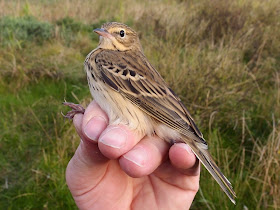A rain curtailed session on the 27th produced 32 new birds and 1 retrap. There was a noticeable arrival of Robins with many heard ticking before first light and 6 were subsequently ringed. Tree Pipits also featured with 4 ringed from the 13 recorded going south. Goldcrests were more vocal than they have been and may have included birds on the move. Ringing totals were (retraps in brackets) - Robin 6, Chaffinch 7, Willow Warbler 5 (1), Chiffchaff 3, Goldcrest 3, Blackcap 1, Tree Pipit 4, Goldfinch 1, Reed Bunting 1, Yellowhammer 1.
The 28th was a quieter day with only 19 birds ringed. The previous day's Robins had moved on and warblers were few and far between. The only Robin caught was of interest because it was still in full juvenile plumage with no sign of post-juvenile moult so must have come from a very late brood. Tree Pipits continued to move in small numbers with another 6 ringed from a total of 9 recorded going south. Other birds going south were 2 Grey Wagtails and a trickle of Meadow Pipits. Ringing totals were - Tree Pipit 6, Chaffinch 4, Bullfinch 1, Chiffchaff 4, Willow Warbler 2, Blackcap 1, Robin 1.
 |
| A very late spotty juvenile Robin (Erithacus rubecula). |
 |
| Grey Wagtail (Motacilla cinerea). |
 |
| Adult Willow Warbler (Phylloscopus trochilus). A rather pale bird with very little yellow and probably of northern origin. |
 |
| Robin (Erithacus rubecula). Arrivals of migrant Robins are easily noticed at this site due to the nature of the habitat and limited number of resident birds. |
 |
| Adult female Redstart (Phoenicurus phoenicurus). The first of the autumn and the first I have caught locally. |
 |
| Juvenile Male Redstart (Phoenicurus phoenicurus). Caught in the same net round as the female above. |
 |
| Juvenile Male Redstart (Phoenicurus phoenicurus). |
 |
| Adult Tree Pipit (Anthus trivialis). The only bird caught today but it brought the total ringed during the month to 51. This total would have been unimaginable just a few weeks ago. |
 |
| Adult Meadow Pipit (Anthus pratensis). |


























